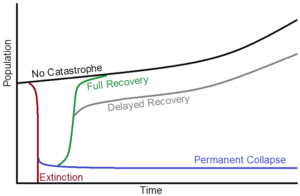GCRI seeks to understand what would happen to survivors of global catastrophes, what can be done to help them, and how this affects the evaluation of global catastrophic risks.
How survivors fare is perhaps the largest and most important point of uncertainty in the study of global catastrophic risk, yet it often goes neglected. At stake is whether extinction events may be categorically more important than catastrophes that leave survivors. Some have argued that extinction events are categorically more important because all future generations are lost. However, this neglects the possibility of sub-extinction catastrophes that cause permanent damage. Unless the survivors recover completely enough to get back on the pre-catastrophe trajectory (shown in green below), catastrophes cause permanent damage and are not categorically less important than extinction events.
The fate of catastrophe survivors is a rather grim and difficult-to-study topic, which may be why it has been neglected. However, it is also a deeply fascinating and important topic. To study the aftermath, GCRI combines insights from archaeology, astrobiology, climatology, demography, economics, futures studies, moral philosophy, risk analysis, sustainability science, and more. GCRI also works on opportunities to assist survivors and increase their odds of avoiding extinction and making a successful recovery. The aftermath could be similar under many different catastrophe scenarios, making it important to address as a single unified topic, instead of handling it separately for each risk.
Featured Publications
Pandemic refuges: Lessons from two years of COVID-19
Baum, Seth D. and Vanessa M. Adams, 2022. Pandemic refuges: Lessons from two years of COVID-19. Risk Analysis, DOI 10.1111/risa.13953.
This paper looks at China and Australia during the first two years of the COVID-19 pandemic to demonstrate that the refuge concept is politically viable and capable of protecting populations during global catastrophes.
Long-term trajectories of human civilization
Seth D. Baum, Stuart Armstrong, Timoteus Ekenstedt, Olle Häggström, Robin Hanson, Karin Kuhlemann, Matthijs M. Maas, James D. Miller, Markus Salmela, Anders Sandberg, Kaj Sotala, Phil Torres, Alexey Turchin, and Roman V. Yampolskiy. Foresight, vol. 21, no. 1, 2019, pages 53-83, DOI 10.1108/FS-04-2018-0037.
This paper evaluates the fate of human civilization millions, billions, or trillions of years into the future. It includes detailed analysis of the long-term prospects of the survivors of global catastrophe, including the probabilities of survivors losing and later rebuilding advanced civilization.
Uncertain human consequences in asteroid risk analysis and the global catastrophe threshold
Seth D. Baum. Natural Hazards, vol. 94, no. 2 (November), 2018, pages 759-775, DOI 10.1007/s11069-018-3419-4.
This paper critiques the treatment of human consequences in the literature on asteroid risk. Asteroids are an important case study because they are arguably the most well-understood global catastrophic risk. However, this paper shows that the human consequences are not well understood, especially for the more catastrophic collisions. The paper shows why the aftermath of global catastrophe is a large and important point of uncertainty in the study of global catastrophic risk.
Additional Publications
Seth D. Baum, 2018. Resilience to global catastrophe. In Benjamin D. Trump, Marie-Valentine Florin, and Igor Linkov (Eds.), IRGC Resource Guide on Resilience (Vol. 2): Domains of Resilience for Complex Interconnected Systems. Lausanne, CH: EPFL International Risk Governance Center.
Seth D. Baum, David C. Denkenberger, and Joshua M. Pearce, 2016. Alternative foods as a solution to global food supply catastrophes. Solutions, vol. 7, no. 4, pages 31-35.
Seth D. Baum, David C. Denkenberger, Jacob Haqq-Misra, 2015. Isolated refuges for surviving global catastrophes. Futures, vol. 72 (September), pages 45-56, DOI 10.1016/j.ecolecon.2014.07.024.
Seth D. Baum, David C. Denkenberger, Joshua M. Pearce, Alan Robock, and Richelle Winkler. 2015. Resilience to global food supply catastrophes. Environment, Systems, and Decisions, vol. 35, no. 2 (June), pages 301-313, DOI 10.1007/s10669-015-9549-2.
Timothy M. Maher, Jr. and Seth D. Baum, 2013. Adaptation to and recovery from global catastrophe. Sustainability, 5(4), pages 1461-1479, DOI 10.3390/su5041461.





